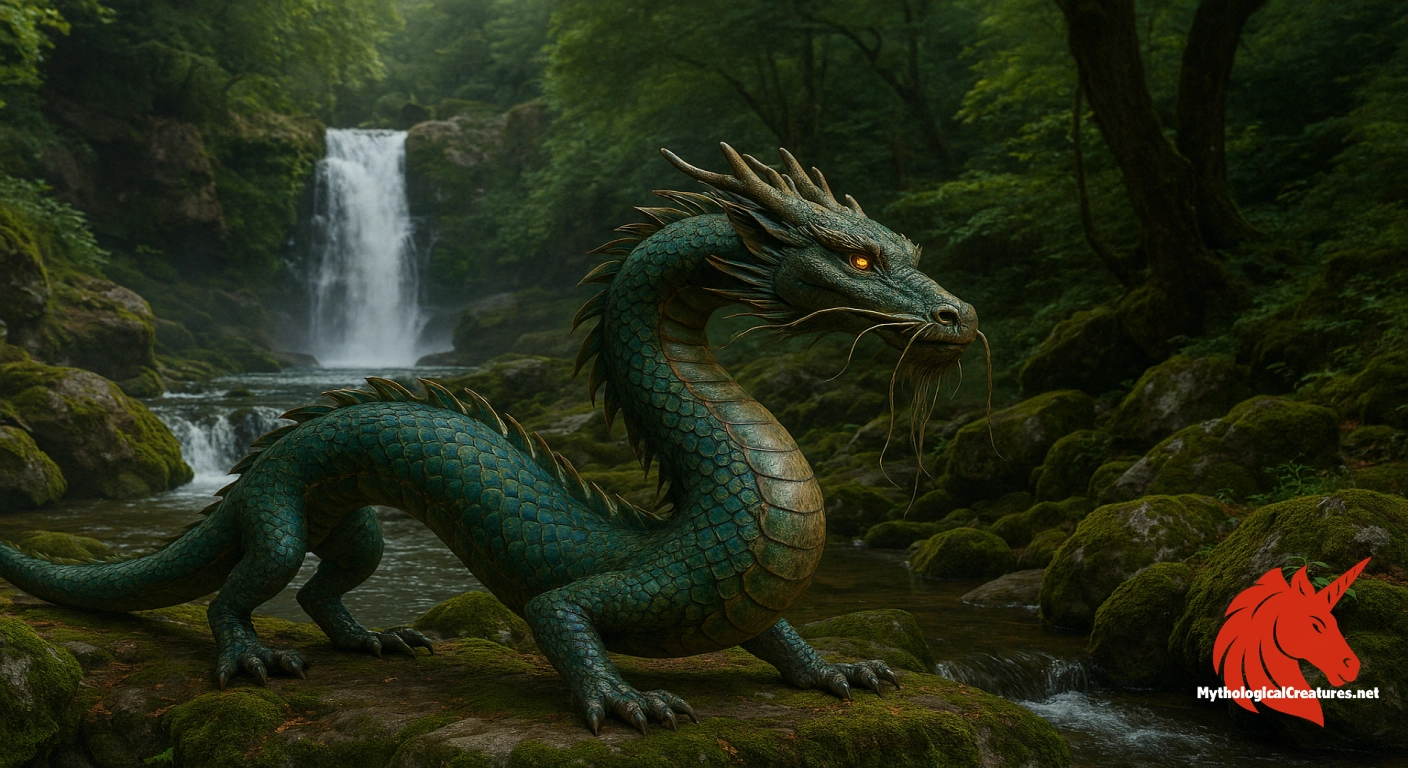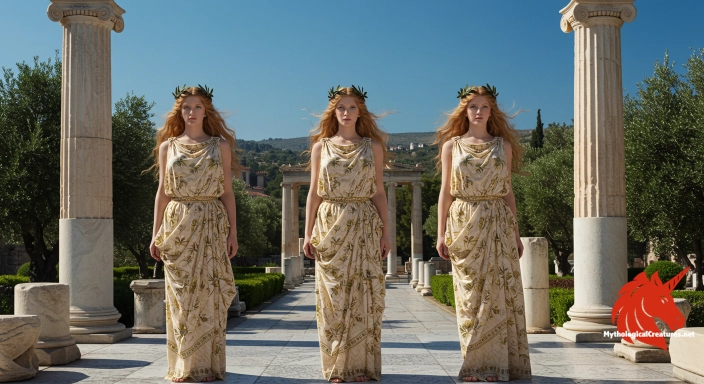Japanese dragon: The Japanese dragon is a legendary, serpentine water deity from Japanese mythology, characterized by its large, wingless form and clawed feet.

Japanese dragon
Japanese dragon - Japanese dragons amalgamate indigenous and foreign influences, representing water deities who control rain and water bodies, integral to agricultural prosperity and natural cycles.
Origins & First Encounters
Japanese dragons emerge as some of the most fascinating entities in the realm of myth, blending native spiritual visions with the elegance of imported legends.
Their origins trace back to an era where the mystical and the natural worlds were deeply intertwined, creating beings that could command both reverence and awe.
These creatures first appear in lore as water deities, reflecting the crucial role that water played in an agrarian society steeped in Shinto tradition.
They were gradually assimilated into a broader tapestry of myth that included influences from China, Korea, and even the Indian subcontinent, which enriched their iconography over time.
In early narratives, these dragons were celebrated not only as harbingers of rainfall but also as protectors of harvests and natural order.
Local beliefs soon fused with these imported ideas, invoking a sense of both benevolence and mystique around the creature.
Artistic representations further enhanced their allure with depictions that highlight their fluid, serpentine forms and otherworldly presence.
The cultural context of Japanese dragons, therefore, is as much about the celebration of nature as it is about the integration of diverse mythic influences.
This synthesis of ideas has ensured that Japanese dragons remain a potent symbol of life’s cyclical forces and natural beauty.
Source Texts & Tale Variants
Historical records and ancient texts offer a mosaic of narratives that have shaped our understanding of Japanese dragons.
These mythic figures appear across a variety of sources ranging from early Shinto documents to later compilations of folklore and temple records.
Local legends, passed down orally through generations, weave intricate storylines in which the dragons emerge as both divine custodians and agents of nature.
Several classical works hint at the dragon’s presence as a manifestation of water spirits, with subtle influences borrowed from neighbouring cultures.
Regional manuscripts and temple murals enrich these accounts, presenting variations that highlight the creature’s grace and elemental power.
Each iteration of the story, whether inscribed in formal historical texts or conveyed through local lore, emphasises the dragon’s essential connection to rain and water.
These diverse sources collectively illustrate how the image of the Japanese dragon has been continually reconstructed and reimagined over the centuries.
This compilation of sources demonstrates the dragon’s multifaceted role, from divine intervener in natural phenomena to a symbol of prosperity within community narratives.
In doing so, they establish a compelling record that bridges ancient tradition with the evolving cultural identity of Japan.
Form & Powers
The physical form of the Japanese dragon is a vision of serpentine elegance, boasting a long, sinuous body that twists and turns like a flowing river.
Its skin is commonly depicted as being covered in intricate scales that glint with subtle hues reminiscent of the natural world.
Notably, these dragons bear clawed feet—often with three, or occasionally four, formidable talons that signal their ancient power.
The head of the creature is usually adorned with a pair of impressive horns, lending it an appearance of both regality and mystique.
Large, luminous eyes often characterise its visage, conveying an unfathomable wisdom and a connection to the natural forces of the land.
Delicate whiskers and flowing tendrils further accentuate its otherworldly charm, intertwining with imagery of mist and cascading water.
Artistic depictions showcase not only a robust physical presence but also the agile, almost liquid movement of its form.
The overall anatomy of the Japanese dragon conveys a duality of strength and benevolence, reflecting its revered status as a divine water spirit.
This careful attention to detail in representations underscores the creature’s role as a harmonious mediator between the terrestrial and the divine.
Regional Faces
The portrayal of Japanese dragons varies considerably from one region to another, revealing the rich tapestry of local traditions and artistic sensibilities.
In some parts of the country, the dragon is depicted as a benevolent guardian that blesses communities with abundant rainfall and a fertile landscape.
In contrast, other regions embrace a more formidable image, wherein the dragon’s presence portends both the fury and the grace of nature.
Coastal areas, for instance, often associate these creatures with the treacherous power of the sea and the mystery of deep waters.
In rural locales, they are celebrated in festival processions and shrine rituals, where their images are both revered and feared.
Traditional narratives in mountainous provinces sometimes conflate the dragon with ancestral spirits and local deities, adding layers of spiritual meaning.
This regional diversity highlights an adaptive mythology that has absorbed influences from varied cultural, geographical, and historical contexts.
Local artisans and storytellers alike have reinterpreted the dragon’s essence, making it a mutable symbol fitting each community’s unique relationship with nature.
Thus, the dragon’s legacy is not monolithic but a vibrant spectrum of interpretations that reflect Japan’s multifarious cultural landscape.
Cultural Parallels
When juxtaposed with its counterparts from neighbouring cultures, the Japanese dragon stands out through its unique blend of elegance and spiritual depth.
Unlike the more imperial Chinese dragons, which are often associated with royal power and celestial mandate, the Japanese variant prioritises its role as a guardian of water and the natural world.
This emphasis on nature and fertility aligns the creature more closely with the Shinto tradition than with the more elaborate courtly symbolism seen in other East Asian depictions.
Interestingly, while Chinese dragons also exhibit a serpentine form, they are frequently endowed with wings—a characteristic that Japanese dragons typically forgo, underscoring a more grounded, earthbound presence.
This divergence highlights the cultural nuances that influence mythological imagery across the region.
Moreover, parallels can be drawn with the Southeast Asian naga, whose serpentine forms and water associations evoke a similar mystique, yet differ in narrative and symbolic context.
Western dragons, by contrast, tend to embody a ferocity and a destructive nature that stands in stark opposition to the benevolent and life-affirming spirit of the Japanese dragon.
Such cross-cultural comparisons illuminate how regional narratives adapt a common mythological archetype to better align with local spiritual and environmental realities.
This comparative exploration ultimately enriches our understanding of how myth evolves to resonate with distinct cultural identities.
Legacy & Modern Evolution
The journey of the Japanese dragon through history is a testament to its enduring appeal and remarkable adaptability.
Once a central figure in ancient myth and local shrine worship, the dragon has seamlessly transitioned into modern popular culture while retaining its age-old symbolism.
Contemporary media such as anime, manga, and video games frequently draw on the mystique of the Japanese dragon, reimagining it within new contexts that appeal to global audiences.
Modern artistic interpretations often blend traditional imagery with cutting-edge graphic design, thus maintaining the creature's relevance in the digital age.
Festivals and cultural celebrations across Japan continue to pay homage to the dragon, integrating it into rituals that underscore themes of renewal and natural balance.
This evolution reflects a broader cultural trend in which ancient symbols are reinterpreted to address modern sensibilities and aesthetic tastes.
As a result, the Japanese dragon remains a vital bridge between the mythic past and the dynamic present, symbolising both heritage and innovation.
The creature’s versatility underscores its role as an enduring emblem, transcending time and adapting to the shifting currents of cultural expression.
In its many modern incarnations, the Japanese dragon continues to inspire wonder and admiration, echoing the timeless allure of its legendary origins.
Interesting Fact
Unlike many Western dragons known for their fire-breathing nature, Japanese dragons are celebrated as water deities, highlighting a striking cultural divergence in dragon mythology.
Quick Creature Info
Associations:
Our Mythic Legendary Rating:

Also Sometimes Known As:
Habitat:
Supernatural Powers:
Physical Attributes:
Abilities:
Behavior:
Lore:
Related Creatures, Tales or Lore
References
Discover Another Mythical Legend You May Not Have Heard Of?
Uncover the mysteries of ancient folklore and expand your knowledge of legendary beings from cultures around the world.
Dare to Meet the Tritopatores....
Mythical Disclaimer: The images and data on this site are derived from various historical and literary sources, but we have found that many myths often have multiple versions and interpretations across references, sometimes contradictory. As a result, these creature depictions are artistic interpretations—imaginative blends of folklore, legend, and a dash of AI guesswork. Because creature descriptions vary widely, our illustrations and accompanying information represent our best effort to honor mythology while bridging creative gaps. Enjoy these interpretations—just remember, we've done our best to respect the stories and validate available data, but in the realm of mythology, details often shift, imagination leads the way, and nothing is ever set in stone!
Curated by the Mythological Creatures Team (rev. May 2025)
